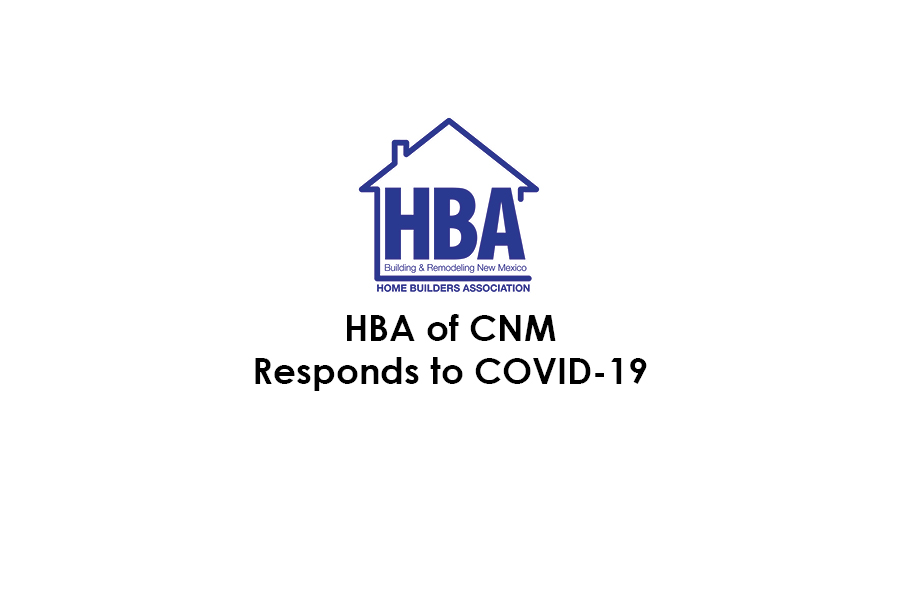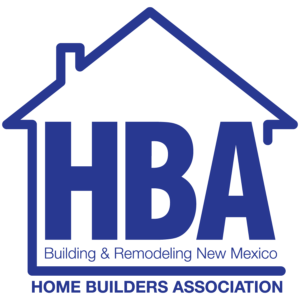
Covid-19 Virus Update HBA Central New Mexico
How does the Governor’s Executive Health order affect my business?
The HBA of Central New Mexico is still operating for you. Based on the most recent news from both the Trump administration and Governor Michelle Lujan Grisham, it looks like the current health guidelines could continue until the end of April. Home Building has been exempted from the health order and allowed to continue as long as workers observe proper distancing and sanitation procedures; last week we included those (OSHA)) guidelines in our post. In addition, the city of Albuquerque and the city of Rio Rancho have agreed to continue with permitting and inspections for new builds or homes in order to maintain essential business operations. Please continue to practice safe and healthy standards in your business.
What is the HBA doing about the Covid-19 Health crisis?
The HBA of Central New Mexico will be operating on a modified schedule with remote isolations however we will be here to answer any questions you may have about the covid-19 virus and how to operate under these new guidelines. Also, we will be calling on you as a member to see if there are any questions you may have and or concerns you need addressed during the health warning cycle and beyond. The Board of Directors has been focused on working with governmental entities to keep your business open and maintaining consistent operations within the HBA. Although there may be some postponements and or changes to the events and activities of the HBA such as the Parade of Homes, we are committed to being the “trusted resource” for the home building community and will act in your best interest accordingly.
Below is some information about how small businesses can take advantage of several federal assistance programs available today. If you have any questions, concerns or ideas, please call the HBA of Central New Mexico at 505-344-3294 or John Garcia, Executive Vice President at 505-980-0985.
I’m considered a small business, what else can I do?
Small Business
Small business owners in all U.S. states and territories are currently eligible to apply for low-interest Economic Injury Disaster Loans (EIDL) of up to $2 million that can provide vital economic support to help overcome the temporary loss of revenue due to the COVID-19 response. Applicants may request an advance in the amount of $10,000 to be delivered within three days of the request. This advance must be used to:
- Provide sick leave to employees unable to work due to the effects of COVID-19;
- Maintain payroll to retain employees;
- Cover increased costs of materials due to interrupted supply chains;
- Make rent or mortgage payments; or
- Repay other obligations that cannot be met due to revenue losses.
An applicant will not be required to repay this advance if it is used for these purposes, even if they are subsequently denied a loan under the EIDL program. Qualified businesses can apply online at disasterloan.sba.gov/ela/. For application assistance, please contact an SBA customer service representative at 1-800-659-2955 or email disastercustomerservice@sba.gov.
Small and medium sized businesses (with fewer than 500 employees) are also eligible to apply for SBA’s expanded 7(a) loan program. This program is not provided through SBA directly, so the first step to qualifying for a 7(a) loan is to find an SBA approved lender in your community. Your lender can guide you through the application process and determine which 7(a) loan product will work best for your business.
Allowable uses of these loans include:
- Payroll costs;
- Certain costs related to the continuation of group health care benefits;
- Employee salaries (including commissions);
- Mortgage, rent and utilities payments; and
- Interest on any other debt obligations that were incurred before the covered period.
A loan recipient may be eligible for forgiveness on a covered loan used for costs including payroll, mortgage and rent obligations, and utility payments.
If you have questions about the 7(a) loan program, you can contact the SBA at 1-877-475-2435 or email 7aquestions@sba.gov. If you are having trouble getting through to, or getting your questions answered by, the SBA, please submit this form and NAHB staff will follow up and provide additional guidance as needed.
New Tax Benefits for Businesses
Employee Retention Credit: Eligible employers are allowed a credit equal to 50% of qualified wages with respect to each employee, on a quarterly basis. An eligible employer means any employer carrying on a trade or business in 2020 during which in any calendar quarter:
- The operation of the trade or business is fully or partially suspended during the appropriate calendar quarter due to orders from an appropriate governmental authority limiting commerce, travel, or group meetings due to COVID-19; or
- The trade or business experiences a significant decline in gross receipts, with a 50% decline in gross receipts when compared to the same quarter in the prior year. Businesses remain eligible until their gross receipts recover to 80% when compared to the same quarter in the previous year.
- Maximum wages, including health insurance benefits, eligible for the credit for all calendar quarters is $10,000.
- For businesses with 100 or fewer employees, generally all wages of full-time employees are eligible.
- For larger businesses, only those wages paid to full-time employees who are not providing services due to a suspension of business operations or reduction in gross receipts are eligible.
- Wages may also include an employer’s qualified health plan expenses allocable to the employee.
- 501 (c) tax-exempt organizations are eligible.
- Employers receiving a loan under section 7(a) of the Small Business Act are not eligible for the employee retention credit.
- Credit is refundable to the extent it exceeds payroll taxes.
New Mexico assistance
New Mexico small businesses in financial distress due to the coronavirus crisis are encouraged to apply as soon as possible for loans made available under the federal stimulus bill.
The stimulus bill, or Cares Act, allocates $349 billion for loans to small businesses. But businesses have until only June 30 to access the money, and loans will be made on a first-come, first-serve basis. “This money will go quickly, and New Mexico small businesses must act as soon as possible to obtain loans,” Economic Development Secretary Alicia Keyes said Saturday. “Many businesses struggling through this crisis need a financial bridge to help them survive and recover once this crisis eases.”
There are two loan programs for small businesses under the stimulus bill: the Economic Injury Disaster Loan Program and the Paycheck Protection Program.
1. Under the Economic Injury Disaster Loan Program, a small business can borrow up to $2 million, with an immediate grant advance up to $10,000 that can distributed in three days to a business.
Small businesses can apply for the loans through the U.S. Small Business Administration at https://disasterloan.sba.gov/ela/.
Applications also can be made through the SBA’s Small Business Development Centers. There are 19 centers in New Mexico, and they offer instruction and guidance on how to apply for the loans. The website for the centers is www.nmsbdc.org
2. Under the Paycheck Protection Program, a small business can borrow up to $10 million, with an interest rate of 1 percent. The loan is deferrable for six months.
The SBA will forgive Paycheck Protection Program loans if all employees are kept on the payroll for eight weeks and the money is used for payroll, rent, mortgage interest or utilities. A small business must work through its lender to apply for a loan. For more information, go to www.sba.gov/paycheckprotection
In addition to the loans made available under the stimulus bill, the New Mexico Economic Development Department also has created loan-guarantee and no-interest loan programs for businesses. For more information, go to https://gonm.biz/
How to Obtain an SBA Loan and Have it Forgiven
This post was updated on April 3.
In recent weeks, Congress has adopted three bills aimed at stabilizing the economy, with more to come. The most notable of these was the $2.2 stimulus package (the CARES Act) that President Trump signed into law on March 27. This law contains a nearly $350 billion federal small business loan protection program called the Paycheck Protection Program (PPP) that will provide significant loan forgiveness for small businesses with fewer than 500 employees if employers meet certain criteria.
Loan Forgiveness
- Under the new PPP loan program in the CARES Act, small businesses with fewer than 500 employees can take out loans equal to 2.5 times their average monthly payroll from 2019 with the total capped at $10 million. For many businesses that meet key conditions on the use of these funds, the loans may be forgiven.
- Businesses applying for an Economic Injury Disaster Loan (EIDL) may request an advance of up to $10,000 to be delivered within three days of the request. An applicant will not be required to repay this advance if the funds are used to cover payroll, provide sick leave or cover other business costs, even if the applicant is subsequently denied a loan under the EIDL program.
NAHB has created an online document, CARES Act and Small Business Lending Programs, that offers more details about these small business lending programs, including the conditions required for loan forgiveness.
A Broad Overview of the 3 Bills: How They May Apply to Your Business
- Stimulus Resources for NAHB Members is a seven-page online document that explains two Small Business Administration lending programs – SBA’s Paycheck Protection Program (PPP) 7(a) loans and its Economic Injury Disaster Loans (EIDL).
- The summary also looks at employee retention credits, delay of employer-paid payroll tax payments, net operating loss (NOL) modifications, and other important measures that may apply to your business.
- As noted above, the two SBA lending programs are critically important because for many businesses that meet key conditions on the use of these funds, the loans may be forgiven.
- The Treasury Department on April 2 released regulations and guidelines on PPP and referenced existing SBA guidelines and language. The Treasury language stipulates that recipients of PPP loans cannot use the funds “for building homes for future sale.” Additional language says “apartment buildings and mobile home parks are not eligible” under the PPP (7a) loan program. Moreover, passive businesses owned by developers and landlords that do not actively use or occupy the assets acquired or improved with the loan proceeds (except as Eligible Passive Companies under 13 CFR § 120.111) are not eligible. This broad building language is unclear and raises many questions. NAHB is seeking clarity and guidance on what this may mean for our members. We are also reaching out to Treasury to modify the language so that it meets the needs of our members.
